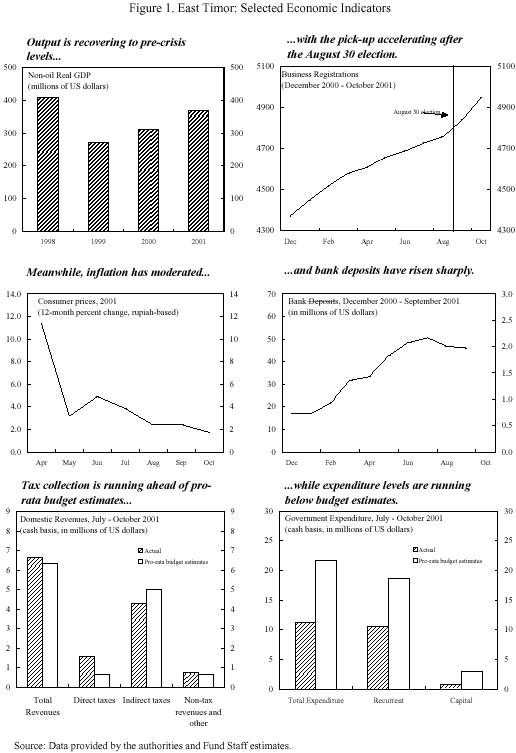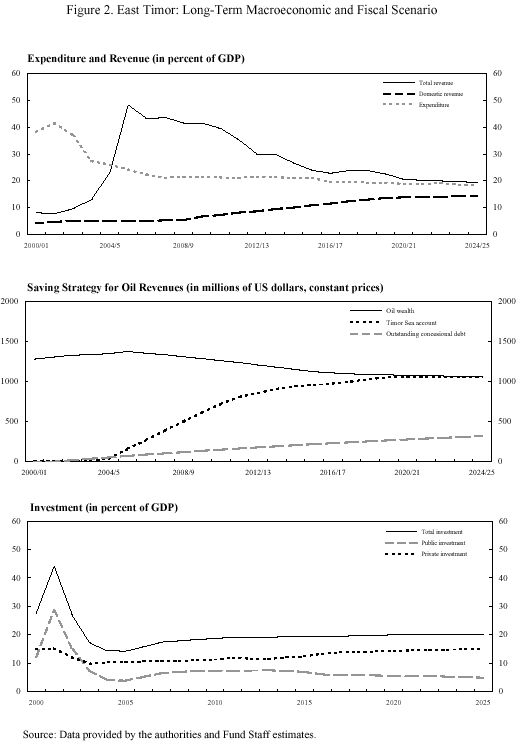Statement by Stephen Schwartz, Deputy Division Chief, IMF Asia and Pacific Department, at a Donors' Meeting on East Timor
December 12, 2001
Deputy Division Chief, IMF Asia and Pacific Department
Oslo, December 11–12, 2001
1. Thank you for the opportunity to address this distinguished gathering. It is indeed heartening to see the progress made over the past two years in restoring political and economic stability in East Timor. These developments are testimony to the UN's skillful management of the transition, the effectiveness of the international community's financial and technical support, and the East Timorese leadership's commitment to fostering the conditions for future prosperity. We at the International Monetary Fund are pleased to have been part of this effort, and look forward to continuing to support East Timor in meeting the challenges that lie ahead.
2. As emphasized in the Background Paper for this meeting, consolidating and building upon the progress made so far will require the continued support of the international community. We therefore support East Timor's request to donors for additional financing over the coming three years. Moreover, with fiscal projections for the current fiscal year broadly on track, we join the authorities in stressing the need for donors to close the financing gap that was presented at Canberra.
3. The remainder of this statement will focus on recent economic developments and near-term prospects, as well as the longer-term macroeconomic framework. The latter has implications for fiscal sustainability and economic growth. The statement will also touch upon efforts to establish strong institutions for economic management in East Timor.
I. Recent Developments and Near-Term Prospects
Recent Economic Developments
4. Since the Canberra donors' meeting last June, economic conditions have continued to improve (Table 1 and Figure 1). Quantification is difficult given the lack of statistics, but based on recent trends and available indicators, overall output this year is projected to approach pre-crisis levels. While the recovery so far has been concentrated in the service sector in Dili―fueled by the sizeable reconstruction effort and presence of international staff--it has recently expanded to the agricultural sector, which accounts for around a quarter of the economy's total output, and up to three-quarters of employment. These positive developments suggest that, while under- and unemployment remain acute, the overall employment situation is improving.
|
5. Recent price and financial developments have also been encouraging. Reflecting a significant easing in the scarcity of goods witnessed in early 2000, rupiah-based CPI inflation stood at only two percent as of October (12-month change). Progress in financial intermediation, however, is mixed. While bank deposits have risen, commercial bank credit is still very limited ($1.8 million as of September), reflecting an absence of adequate collateral and other risk factors. Meanwhile, efforts by the Central Payments Office (CPO) to promote the U.S. dollar as East Timor's sole currency are continuing. In addition to administering an education program, the CPO has carried out rupiah exchanges, facilitated by a repatriation agreement with Bank Indonesia which has just been extended for another six months. Nevertheless, the Indonesian rupiah continues to be widely used, indicating that the dollarization process is far from complete. 6. Recent fiscal developments indicate that revenue and expenditure targets for this year's CFET budget are broadly on track. On the revenue side, direct taxes (income tax collection) are running ahead of budget estimates (due to one-off payments relating to income for 2000), while indirect taxes (border and service taxes) are running somewhat below expectations (due to low imports in the run-up to the August election). On the expenditure side, budget execution has fallen short of targets through October, but is expected to pick up with the reallocation of spending priorities undertaken by the Council of Ministers. The main concern for the remainder of the year relates to the still unfinanced gap of about $10 million (assuming that pledged contributions of $7 million are received), which could give rise to a cash squeeze. Additionally, notwithstanding improved billing collections, a deficit in the power sector could necessitate an increased budgetary transfer. Near-term Economic Outlook7. Though economic conditions have improved, the near-term outlook is clouded by the pending withdrawal of UN and related staff, and the still unfavorable climate for private investment. Given the adverse impact of the withdrawal on economic activity (as described in the Background Paper), near-term growth prospects will depend on the extent to which private sector activity can fill the void. While some private sector observers expect a severe contraction next year, we believe that real growth over the next 1-2 years is likely to be zero or slightly positive, given that there will still be a significant international presence, and indications that the recovery has become more broad-based. 8. In a well functioning economy, resources freed up by the decline in activity in one sector would work their way toward other productive activities. While this will no doubt occur in East Timor, prospects for a rapid recovery are hampered by impediments to private investment, including the lack of: (i) skilled labor; (ii) adequate infrastructure; (iii) legislation for property rights and land ownership; and (iv) a legal and regulatory framework for business. The attention these impediments have received in the present meeting is well-founded, and the East Timorese authorities' commitment to accelerating progress in these areas is encouraging. It will also be important to implement flexible labor market policies by allowing high wages rates--reported in some cases to be 2-3 times the prevailing rates in neighboring countries―to adjust downward in response to changing labor market conditions. Near-term Fiscal Outlook9. The broad magnitudes of the three-year budget outlook presented at this meeting appear to be within a reasonable range, consistent with East Timor's development needs. The presentation implies a three-year cumulative external financing need of $154-184 million for the CFET budget (Table 2). After taking into account indicative ranges for direct bilateral support for technical assistance, capital projects, international staffing, and newly identified transition costs, the total financing need amounts to $304-354 million (excluding TFET). These estimates are based on realistic revenue projections and a continuation of the current policy to accumulate first tranche petroleum revenues. The latter merits support in order to establish the principle of saving oil revenue, and to build a base of international reserves. 10. A definitive assessment, however, would need to await details on the composition of spending and the recurrent costs associated with new capital spending. In this regard, it is reassuring that the authorities are committed to allocating spending to the highest priorities, and are cognizant of the need to assess the recurrent cost implications of new capital projects. We also support the authorities' plans to improve tax administration and to explore measures to increase revenue over the medium term. 11. In the interest of fiscal transparency and efficiency, donors should be encouraged to channel as much of their support as possible through the CFET budget, effectively bringing capital projects on-budget. The effort to bring on-budget $25-35 million per year in capital programs previously funded under TFET merits support, as would an effort to bring on budget the proposed $20 million in capital and development costs of transition. II. Macroeconomic Framework and Fiscal Sustainability12. As the government and its donor partners are aware, the three-year budget outlook should be assessed within the context of long-term fiscal sustainability. The analysis needs to take into account the expected future oil revenue stream, which is likely to commence in 2005/06. It will be important to manage these revenues effectively, to maintain macroeconomic stability, foster the development of the non-oil economy, and ensure sufficient savings for future generations. In this regard, the government's endorsement of a sound saving/investment strategy is welcome. 13. In discussions with East Timor's economic team, IMF staff have assessed fiscal sustainability within a comprehensive macroeconomic framework (Figure 2). Based on the latest oil revenue projections, which are significantly higher than those available in Canberra, the analysis suggests that the three-year budget proposal gives rise to a sustainable fiscal path over a longer time horizon. Importantly, however, this assessment hinges on the implementation of sound policies needed to generate a stable macroeconomic environment and high rate of growth of the non-oil economy. 14. The assessment is based on a scenario consistent with a poverty reduction strategy. It envisages an ambitious, though achievable, growth target for the non-oil economy of six percent over the long term. The large fiscal deficits projected over the next few years would yield to surpluses as the significant oil revenues commence (Figure 2, top panel). Following the high expenditure levels associated with the reconstruction effort, total spending would stabilize at around 20 percent of non-oil GDP, a level consistent with the economy's absorptive capacity, and capital spending needs. For the scenario to be sustainable, and to avoid an over-reliance on oil revenues, domestic resource mobilization will be required. While the domestic resource base is constrained over the near term by the low level of economic activity and limited administrative capacity, over the longer term implementation of revenue measures would ensure a steadily rising domestic revenue-to-GDP ratio (an IMF technical assistance mission is scheduled early next year to assess medium-term revenue issues). The fiscal strategy is sustainable in the sense that expenditure would be fully covered by domestic revenues, interest earnings on oil savings, and a manageable level of concessional borrowing. 15. In devising a savings strategy for oil revenues, a useful point of departure would aim to keep real oil wealth constant. This would imply spending only the interest component of the stock of oil wealth, to ensure that such wealth is passed on fully to future generations. The scenario presented above is somewhat less stringent, as it would enable some oil wealth to be invested over time in projects with high rates of return (at least as high as the returns on financial savings), including on health and education. This would permit a public investment level sufficient to support the targeted economic growth rate (Figure 2, bottom panel). 16. It is important to note that the scenario described above is illustrative, as it is sensitive to underlying assumptions―oil prices and volumes, among others―and the supporting policy package. The following policy requirements to achieve an ambitious growth target are worth highlighting:
III. Institution Building17. Developing strong institutions will be critical for effective economic management. The recently established Planning Commission has been instrumental in performing a coordinating role and establishing priorities for the forthcoming national development plan. With respect to the areas in which the IMF has provided direct support, significant progress has been made to strengthen the Central Fiscal Authority (CFA), which is now effectively carrying out the functions of a Ministry of Finance. The recent passage of the Banking and Payments Authority regulation is welcome, as it will bring the CPO closer to a properly functioning monetary authority, whose objectives include preserving price stability, fostering the liquidity and solvency of the financial system, executing foreign exchange policy, and promoting a safe, sound, and efficient banking and payments system. Work to build a statistical base has advanced with the installment of an IMF-supported advisor to coordinate efforts across agencies, including with respect to the national accounts exercise. IV. Concluding Remarks18. The support of the international community and commitment of East Timor's leadership to establishing the conditions for economic growth and stability have achieved results. To sustain this progress, much remains to be done. In addition to capacity building and establishing strong economic institutions, the most important task is to promote an environment conducive to private sector development. This, in turn, will require additional investments in physical and human capital, implementation of an adequate legal framework to facilitate private investment, and sound economic management. The IMF will work in support of these efforts, including through the continued provision of technical assistance, training, and policy advice. At the request of the East Timorese authorities, we also look forward to initiating the membership process, with a view to East Timor joining the IMF and World Bank as close as possible to independence. |




